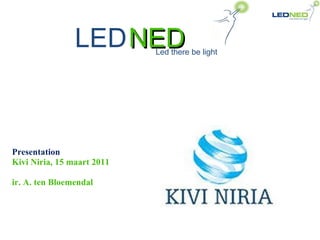Kivi Niria 15 Maart
- 1. NED Presentation Kivi Niria, 15 maart 2011 ir. A. ten Bloemendal LED Led there be light
- 2. Ėý
- 3. LedNedbv. Founded in 2004 Headquarters Helmond Netherlands LedNed â s global reach 120 employees various companies in 7 countries Dutch design & engineering Worlds first & only KEMA CE Specialized in functional White Light LedNed Global NLT &LedNed Asia Zenith LedNed USA LedNed Middle East
- 4. Strategy LedNed strives to be the leader in functional white Led, in principle based on retro-fit, focussed on the B2B market with a active spin off towards the consumer market (part of the range is suitable for consumer market) . LedNed differentiates based on the 4 Qâs Quality (of sight) Quality (of energy behaviour, PF > 0,8) Quality (of life time) Quality of safety Kema/Dekra certified
- 5. TU/E, Testing, Quality, reliability, Enginering. LedNedAsia, R&D, Enginering, manufacturing Dial, Photometrics, advice, implementing software. Cree, LED âs, R&D, Enginering KEMA, Quality, safety, advice NMI, Advicephotometrics Prospects, Pilots, Tests environments 3th party, non LedNedproducts, Advice. Product development
- 6. Major markets are based on replacement of Fluorescent tubes: Offices: In general replace Tubes with FLP Better light distribution Higher light output Better looks Logistics / Production Up to 7 or 8 meters replace 1 on 1 with Led Tubes / B&P Excellent economics Very good lifecycle Very good sight (contrast) Above 8 meters install Light Line / B&P Best in class light distribution (3D) Multi fuctional (emergency, dimming etc) IP 66, Atex 2 Unbeatable lifecycle and lumen guarantee
- 7. Ėý
- 8. Developments Oleg Vladimirovich Losev published in 1927 about light emission of diodes used in radio transmitters. The currently used Light Emitting Diode (LED) is developped in 1962 by Nick Holonyak jr. (General Electric) Although he is generally viewed as the person who invented the LED, as shown other people have published about the same phenomenon.
- 9. High Power Led CREE X-Lamp Reflector Floating Lens Led die & phosphor Substrate
- 10. Ėý
- 11. Ėý
- 12. Ėý
- 13. Ėý
- 14. The human Eye The instrument used to detect visible EM radiation is the human eye . It can detect radiation with wavelengths in the range 380 â 760 nm. The sensors that detect light in the retina are called the rods and cones Rods, are sensitive to luminance levels between 10-6 and 10-2 cd/m2. This is called scotopic vision. Almost no color perception! Cones, become operational at 10-2 and 10 cd/m2, colour differentiation starts to occur, this is called mesopic Vision. Above 10 cd/m2 cones are fully operational, this is called Photopic vision. The last receptor called the photosensitive retinal ganglion cells . The function is a non-image-forming (NIF). They provide a stable representation of ambient light intensity,also playing a major role in synchronizing circadian (bio)rhythms, pupillary control and release of the hormone melatonin (sleep).
- 15. Light Combining all of the available knowledge to the specific characteristics of a light emitting diode(LED), has given led-lighting designers en engineers today all the tools within reach to take light into a new era.
- 16. Ėý
- 17. Ėý
- 18. Ėý
- 19. Area 3 Fluorescent Tube
- 20. Area 3 LED Tube
- 21. Ėý
- 22. Power Factor Definition and calculation AC power flow has the three components: real power (P), measured in watts (W); apparent power (S), measured in volt-amperes (VA); and reactive power (Q), measured in reactive volt-amperes (var). The power factor is defined as: P / S (Îŧ= P/S ) In the case of a perfectly sinusoidal waveform, P, Q and S can be expressed as vectors that form a vector triangle such that: S 2 = P 2 + Q 2 ĖýĖýĖýĖýĖýĖýĖýĖýĖýĖýĖýĖýĖýĖýĖýĖýĖýĖý If Ï is the phase angle between the current and voltage, then the power factor is equal to |cos ÎĶ |, and: P = S . |cos ÎĶ | ĖýĖýĖýĖýĖýĖýĖýĖýĖýĖýĖýĖýĖýĖýĖýĖýĖýĖýĖýĖýĖýĖýĖýĖýĖýĖýĖýĖýĖý Since the units are consistent, the power factor is by definition a dimensionless number between 0 and 1. When power factor is equal to 0, the energy flow is entirely reactive, and stored energy in the load returns to the source on each cycle. When the power factor is 1, all the energy supplied by the source is consumed by the load. Power factors are usually stated as "leading" or "lagging" to show the sign of the phase angle.
- 23. Voorbeeld:
- 24. Ėý
- 25. Ėý
- 26. High Power Led CREE X-Lamp Reflector Floating Lens Led die & phosphor Substrate
- 27. Ėý
- 28. Ėý
- 29. Ėý
- 31. Ėý
- 32. Ėý
- 33. Ėý
- 34. Thanks for your attention


































